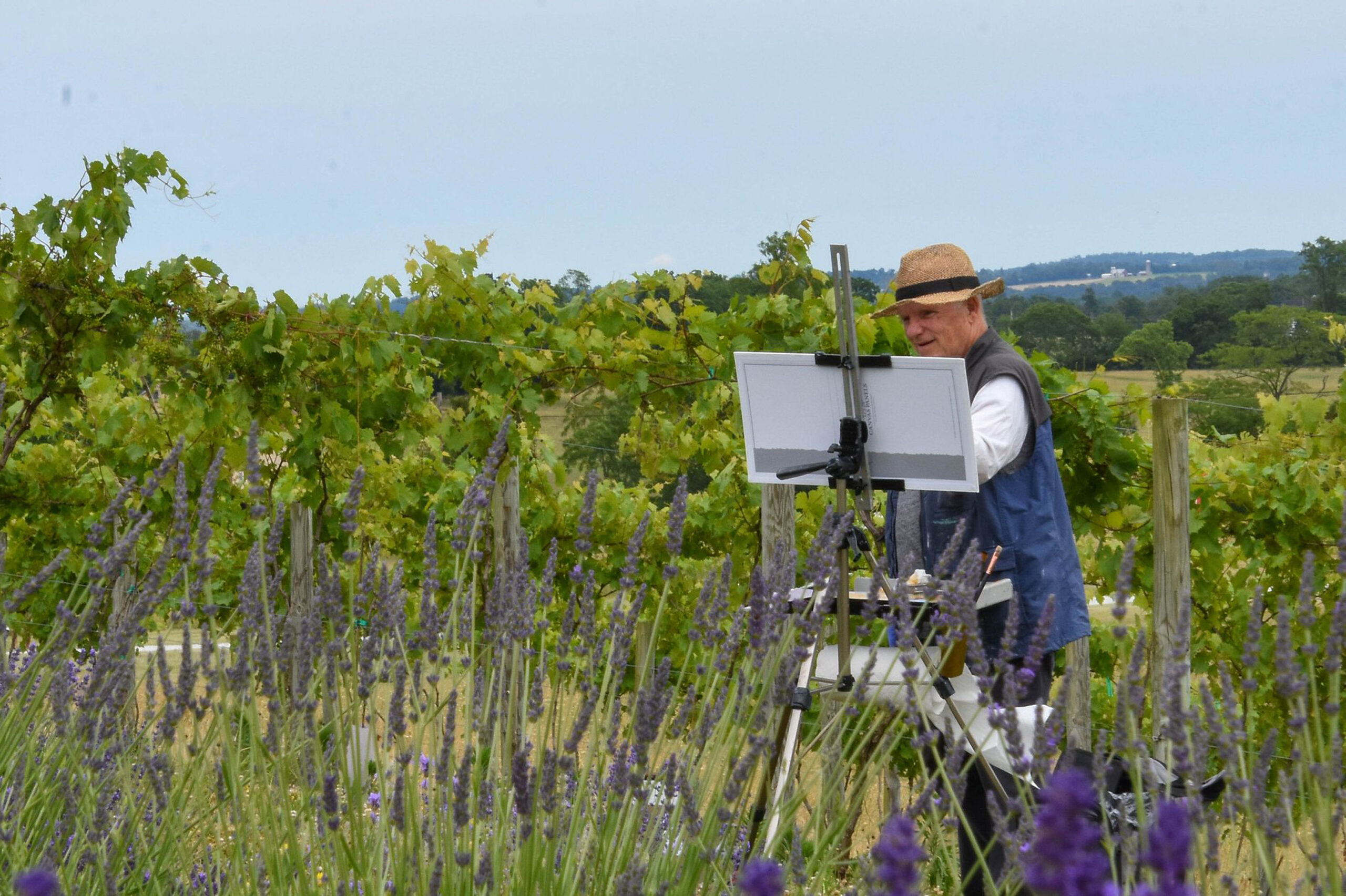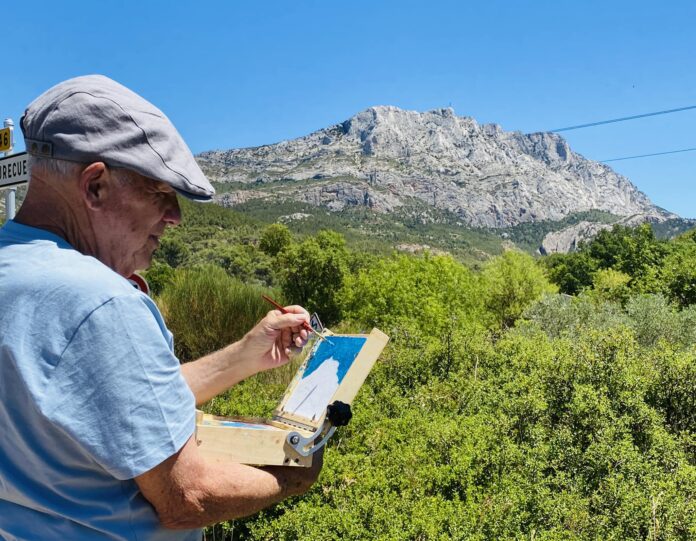Painting Outside No Matter What > Be inspired by 77-year-old artist John MacArthur and his story of passion and persistence. And read through to the end to see John’s humorous and helpful advice for other outdoor painters.
Due to health issues, John found himself painting less and less. “My plein air options exist in a circle that seems to contract on a hidden whim, and it was getting depressing,” he says. “I found comfort sleeping or watching art videos on YouTube.”
Then, while recuperating from a surgery, he found himself with a copy of PleinAir Magazine and was newly inspired to attempt painting outside while the cherry blossoms were blooming in his home area of Washington, D.C.
“I took my cane and a stripped-down plein air setup and headed to the Tidal Basin,” he says. “You’ll find, later in life, your memories of beauty are much crisper than the prolonged ordeal to reach that beauty.
“Plein air amidst the largest annual tourist attraction in D.C. every year is much different than other events. Imagine attempting plein air at Times Square at 11:30 pm on December 31. The only difference may be [the crowd is] less inebriated at the Basin, but the crowds are every bit similar in size.
“After I set up, a young man asked if he could observe. I allowed it would be a pleasure, and he settled in adjacent to my left shoulder to begin sketching.
“We were both calmly focused, attempting to capture the scene, a couple of feet apart with a slick, muddy hill between us. For some reason, a middle-aged chap thought he could squeeze between us to watch us from behind, but he slipped and tumbled into me and on top of my setup. He ended up with a lovely cerulean blue streak on his pants and a fine puddle of turpentine in his lap.
“I straightened everything up, and the only casualties were a smear and two long brushes snapped in half. The smear was no big deal, and was easily fixed. The brushes were sort of wounded-in-action soldiers but still suitable for studio work.
“At about 5 o’clock, I called it a day. The young man did really nice sketches and thanked me, and we headed our separate ways. Due to traffic, I didn’t manage to get out of the area until after 8 o’clock, and it took another hour to drive home. I wonder if many in the general public realize an 8” x 10” can involve 10 or so hours.”
After this long day of painting and traveling, John got home and continued reading the magazine with joy. A few days later, the peak blooms were beginning to end and the temperature was near 65 degrees. John was tempted again by the call of plein air painting.
“I knew I could not drive, but darn it, it was VanGogh’s birthday,” John says. “He suffered more than me, to leave so much more behind. So I made up my mind. I packed up a French easel and headed out on foot.”
It had been 40 years since John had taken a bus, but that didn’t stop him from re-learning public transportation. He found a little help along the way to take care of the bus fare and then made his way to the subway, where he was shown how to get a fare card and make transfers. When the train took off, it did so “with a lurch,” causing him to fall, but to no more harm than general embarrassment.
He made it safely to the Smithsonian, where he was struck with an idea: to paint the flower blossoms from one of the paddle boats that tourists use. It was still an optimistic day; he didn’t know the fate that awaited him.
“I went down to the dock and began to chat up one of the workers,” John recalls. A sympathetic dock worker, who was dating an artist, helped make it possible for John to rent a boat.
“I painted until sunset from a rocking paddle boat (note: even with a fine liner brush from Rosemary, straight lines or even control of crooked lines was darn near impossible). When finished, I packed up, went ashore, and found a park bench to rest on. Standing on a rocking boat, maintaining balance while mixing colors and pushing paint, was doggone tiring, and somehow one of the clips for the shoulder strap had disappeared, so I had to carry the easel by hand.”
John continued his journey back home, which included crossing a street with a group of tourists. “My toe caught the curb and I went soaring face-first into the sidewalk. I recall seeing my easel flying on my left, sans painting, which was flying ahead of me, painted side down. Even as my face and hands hit the sidewalk, ‘My painting!’ was all I could cry out. People were scrambling. The easel had broken apart. I was crawling to at least turn the painting over.”
Someone said, “Stay down, sir. You’re bleeding badly. Someone call an ambulance!” But John replied, “I don’t care about that, I have to get to my painting.”
He says, “I did, and made sure the blood dripped on the back. I couldn’t get up, and EMTs arrived. I was helped to my feet. I explained that I didn’t need more assistance, I just needed to get to the Metro. I thanked everyone profusely and hobbled the half-mile to the station.
“I made my way down the stairs (of course the escalator was not working), got on the train, found a seat, and tried to take stock of my condition. There was blood on my hands and face, and broken pieces of my easel held together with a small bungee cord. The painting was a bit battered, but not destroyed.”
Once home, John relaxed. “I sat reading my copy of PleinAir Magazine and realized it was actually created for moments like this.”

John’s Advice for Fellow Artists:
1. Before you leave, double-check your equipment. I know from firsthand experience that it is possible to trek into the wild, discover just the spot, and realize the sun (well, technically the earth) is moving, and oops, you forgot your __________. Don’t be that guy.
2. Don’t bother “chasing the light.” No one has ever caught it. Work big shapes first. Yeah, shapes are boring, until you do it and realize it works.
3. Having the sun behind you will make it hard to get values right because of the glare. So coat your canvas before you leave home. Use a midrange like yellow ochre or burnt sienna. Leave the white at home.
4. Set an alarm on your clock for when you wish to leave. You can get so deep into what you are doing, time will fly by. “Lost in pigment” is a real danger.
5. I try to have a spot in mind, a target if you will. I do not stop or waver. It’s kind of like being on a mission. Keep moving. Ignore doubts, naysayers, and critics — paint, paint, and then paint some more.
6. If you are relatively new to plein air, start small. Do studies — 5” x 8”, 6” x 8”, or 8” x 10”. Less canvas to fill takes the pressure off.
7. You really only need a cool and warm of each primary and white (black if mixing phthalo green and cad red is scary for you).
8. Take breaks. Step back 10 feet and look at what you have done. Pause before any corrections. Take another minute to enjoy the environment.
9. Police your area. Leave it cleaner than when you got there. You will really feel good about it when you are walking away.
10. If going with a group, you do not have to outrun a bear. You only have to outrun one other person in the group.
And browse more free articles here at OutdoorPainter.com




